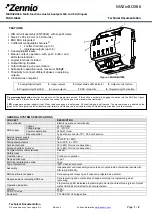
Table 1: DIP switch settings
D1 Switches
D2 Switches
Device Settings
1
2
3
4
1
2
3
4
Serial line baud rate 19200 OR User defined receiver
slots
OFF*
OFF*
Serial line baud rate 38400 OR 32 receiver slots
OFF
ON
Serial line baud rate 9600 OR 128 receiver slots
ON
OFF
Serial line baud rate Custom OR 4 receiver slots
ON
ON
Parity: None
OFF*
OFF*
Parity: Even
OFF
ON
Parity: Odd
ON
OFF
Disable serial (low power mode) and enable the receiver
slots select for switches 1-2
ON
ON
Transmit power
900 MHz radios: 1.00 Watt (30 dBm)
2.4 GHz radios: 0.065 Watts (18 dBm) and 60 ms
frame
OFF
Transmit power
900 MHz radios: 0.25 Watts (24 dBm)
2.4 GHz radios: 0.065 Watts (18 dBm) and 40 ms
frame
ON *
Application mode: Modbus
OFF*
Application mode: Transparent
ON
MultiHop radio setting: Repeater
OFF
OFF
MultiHop radio setting: Master
OFF
ON
MultiHop radio setting: Slave
ON
OFF
MultiHop radio setting: DXM LCD Menu Control
ON *
ON *
* Default configuration. The default settings for D2 DIP switches 1, 3, and 4 are ON. This allows for forcing the device into
Master mode and DXM menu control for the radio power settings.
3.1.1 Application Mode
The MultiHop radio operates in either Modbus mode or transparent mode. Use the internal DIP switches to select the mode
of operation. All MultiHop radios within a wireless network must be in the same mode.
Modbus
mode uses the Modbus protocol for routing packets. In Modbus mode, a routing table is stored in each parent
device to optimize the radio traffic. This allows for point to point communication in a multiple data radio network and
acknowledgement/retry of radio packets. To access a radio's I/O, the radios must be running in Modbus mode.
In
transparent
application mode, all incoming packets are stored, then broadcast to all connected data radios. The data
communication is packet based and not specific to any protocol. The application layer is responsible for data integrity. For
one to one data radios it is possible to enable broadcast acknowledgement of the data packets to provide better throughput.
In transparent mode, there is no access to the radio's I/O.
3.1.2 Baud Rate and Parity
The baud rate (bits per second) is the data transmission rate between the device and whatever it is physically wired to. Set
the parity to match the parity of the device you are wired to.
3.1.3 Disable Serial
Disable an unused local serial connection to reduce the power consumption of a data radio powered from the solar assembly
or from batteries. All radio communications remain operational.
Sure Cross
®
DXM100-Bx and DXM1000-Bx Wireless Controllers
www.bannerengineering.com - Tel: + 1 888 373 6767
19














































